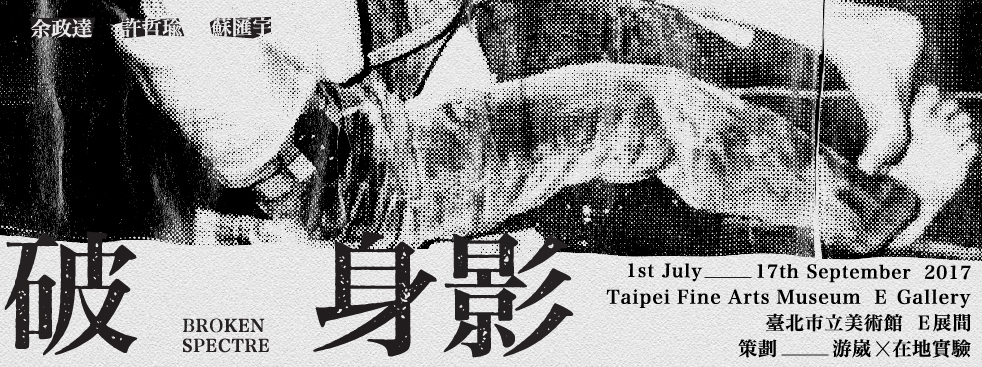Broken Spectre
Date:2017/07/01 – 2017/09/17
Venue:Gallery E, Taipei Fine Arts Museum
Artists: Yu Cheng-Ta, Hsu Che-Yu, Su Hui-Yu
Curator: Yu Wei
Curatorial Team : ET@T
The three commissioned video installations by Hsu Che-Yu, Su Hui-Yu and Yu Cheng-Ta in this exhibition respectively echo three archives of Taiwan’s cultural history in the 1990s, including the Taipei Breaking Sky Festival (1995), the plays by the Taiwan Walker Theatre in its early days, and an article featuring a discussion on the queer body in Isle-Margin, a magazine of cultural criticism. This exhibition gazes again at the physical function-based cultural practices shaped by wrecked body, sensual pleasure and unmaterialised utopia during that period of time.
The historical texts underpinning the three works were somewhat unorganized at first glimpse, yet they coincidentally embodied a kind of playful, interfering, hybridised and vernacular cultural practices that contrast starkly with the eloquent, systemised discourses of the mainstream culture. In the exuberant underground scene after the lifting of martial law (1987) and the Wild Lily Student Movement (1990), the broken corporeality metamorphosed into various little narratives. They have crept up on the liberation of Politics as its shadow, and have been transformed into a counter-culture strategy, which also inspired the imagination about periphery and rebellion throughout the 1990s.
Broken Spectre, the title of this exhibition, not only refers to the keyword pò (broken / to break) of Taiwan’s underground culture in the 1990s, but also insinuates the term “Brocken Spectre,” a phenomenon which occurs when the sun shines from behind the climbers who are looking down from the peak into the mist. The sunlight projects their shadows that are enlarged through the mist, which had been mistaken for spectres. This exhibition managed to turn this huge, ghost-like silhouette erecting in front of us into a historical metaphor—it is a projection of the human body like yours and mine on the one hand, and resembles a ghost summoned out of the physical body by necromancy on the other.
This exhibition is dedicated not so much to representing historical facts as to capturing the spectre of cultural history. In addition, the three commissioned works are not simply the terminal lucidity of the broken corporeality, but also the tribute to as well as the adaptation and re-imagination of Taiwan’s modern cultural archives.
About Artist:
Hsu Che-Yu Earning his master’s degree from the Graduate Institute of Plastic Arts, Tainan National University of the Arts, Hsu Che-Yu works as a freelance artist who primarily creates animations, videos and installations that feature the relations between media and memories. What matters to the artist is not simply the history of events traceable through media, but also the construction and visualization of memories, be they private or collective. His previous solo exhibitions had been hosted by Taipei Fine Arts Museum, Kuandu Museum of Fine Arts, Society for Arts and Technology (Montreal, Canada), and Digital Art Center Taipei. Recently Solo Exhibition:No News From Home, Vanguard Gallery, Shanghai,(2016);Microphone Test, Taipei Fine Arts Museum, Taipei,(2015);The Nameless Man, Kuandu Museum of Fine Arts, Taipei, Taiwan(2012); Yuan Zhi-Jie, Society for Arts and Technology, Montreal, Canada (2012); The Nameless Man, Digital Art Center, Taipei, Taiwan(2011). Group Exhibition:The Third Today’s documents:BRIC-à-brac:The Jumble of Growth, Today Art Museum, Beijing(2016);Public Spirit, Center for Contemporary Art Ujazdowski Castle, Warsaw, Poland(2016);Time Test: International Video Art Research Exhibition, CAFA Art Museum, Beijing,(2016).
About Curator:
Yu Wei, Art writer and curator. Born in 1976, Yu obtained his MA in Art History and Art Criticism from Tainan National University of the Arts in 2003, and has served as an editor for Artco magazine in Taiwan from 2005-2007. Covering Taiwan’s art scenes and visual culture in post-war era, he has written articles for various art journals and exhibition catalogues; and has participated in the exhibitions, View–Point: A Retrospective Exhibition of Li Yuan-chia (2014), as the UK research coordinator, and Altering Nativism: Sound Culture in Post-war Taiwan (2014), as one of the co-curators. Between 2015-16, he curated Shoot the Pianist: the Noise Scene in Taipei 1990-1995 at Peltz Gallery and organised the sound art events, Undertone (2015) and Formless (2016), in London. He is currently a PhD candidate in Humanities and Cultural Studies at Birkbeck (London Consortium), University of London.
ET@T Funded and established by artist Huang Wen-Hao, ET@T has explored all possible art forms and nascent states of production in digital culture since 1995. ET@T’s organizational mission is to blend concept and practice in a cooperative working environment and objectively observe and reach out to various communities in the contemporary art field. For more than twenty years, ET@T has brought together Taiwanese digital artists and presented the unique characteristics of Taiwan’s landscape and figures through different art forms and perspectives. A goal of the organization is to contemplate connections among places within Taiwan, Taiwan itself, and the world. ET@T hopes that its practice of comprehensively applying professional knowledge to digital texts, theories, exhibitions, and performances derived from digital culture, will result in abundant experience and learning.

